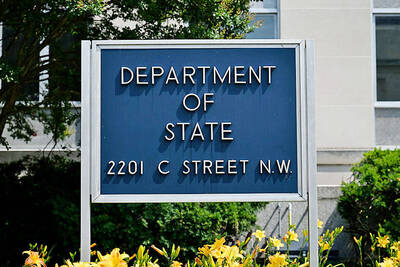The NT$47 billion (US$1.69 billion) budget allotted by the air force for fiscal 2022 to 2027 is to be used to purchase assorted US missiles — ranging from the AGM-88 to the AGM-84H — for its fleet of F-16 jets, which can only carry US-made armaments, the air force said yesterday.
The funding of the “Project to Obtain Ranged Precision Armaments for the F-16 Jet” is in line with the military’s strategy of “defense first, layered deterrence” and the Ministry of National Defense’s “Joint Air Denial” program, the air force said.
The goal is to effectively paralyze targets that pose a threat to Taiwan and to reduce the enemy’s anti-air capabilities, it said.
While the air force has only budgeted NT$550 million for the program in fiscal 2022, the budget is between NT$3.3 billion and NT$21.4 billion a year from 2023 to 2027.
A source speaking on condition of anonymity said that it is highly likely the purchased missiles would be the AGM-88 High-speed Anti-Radiation Missile (HARM), the glide bomb AGM-154 Joint Standoff Weapon (JSOW), the AGM-84H Standoff Land Attack Missile-Expanded Response, the B variant of the AGM-99 and the C variant of the AGM-154.
The source said they deduced the list based on past practices in which the Ministry of National Defense formally announces proposed purchases after the Defense Security Cooperation Agency of the US Department of Defense has released details of an arms sale.
The administration of former US president Donald Trump in June 2017 sold Taiwan AGM-88 HARM and AGM-154 JSOW missiles, as well as AGM-84H missiles last year for a total of US$1.41 billion, the source said.
The ministry’s five-year armament plan also says that it intends to acquire the AGM-84H, the AGM-88B and the AGM-154C for the F-16 jet, the source said.
The ministry’s budget also sets aside NT$21 million from fiscal 2022 to fiscal 2025 to acquire four General Atomics Aeronautical MQ-9B drones, which then-minister of national defense Yen De-fa (嚴德發) in November last year said were for “monitoring purposes,” although the budget item is listed as “armed” drones.
The Air Force Command Headquarters’ budget proposal says that it intends to establish a fleet of drones that are capable of staying in the air for prolonged periods, have real-time data and image transmission capabilities, can operate in the day and at night, and can be armed.
The drones, if armed, could provide support during a defensive battle, the air force said.
Meanwhile, the navy has set aside NT$43.1 billion to upgrade its Kangding-class frigates’ anti-air and anti-missile capabilities, the most expansive upgrades made to the frigates in their 25 years of service.
The navy has spread the budget across nine years with the upgrades expected to be completed in 2030.
The frigates are currently armed with Hsiung Feng II anti-surface missiles and Sea Chapparal anti-air missiles.
However, the Sea Chapparal missiles have a range of only 8km and the navy wants to replace them with the domestically developed shipborne variant of the Tien Chien II (Skysword) missile system, which has a range of up to 30km.
This story has been amended since it was first published.

A car bomb killed a senior Russian general in southern Moscow yesterday morning, the latest high-profile army figure to be blown up in a blast that came just hours after Russian and Ukrainian delegates held separate talks in Miami on a plan to end the war. Kyiv has not commented on the incident, but Russian investigators said they were probing whether the blast was “linked” to “Ukrainian special forces.” The attack was similar to other assassinations of generals and pro-war figures that have either been claimed, or are widely believed to have been orchestrated, by Ukraine. Russian Lieutenant General Fanil Sarvarov, 56, head

SAFETY FIRST: Double the number of police were deployed at the Taipei Marathon, while other cities released plans to bolster public event safety Authorities across Taiwan have stepped up security measures ahead of Christmas and New Year events, following a knife and smoke bomb attack in Taipei on Friday that left four people dead and 11 injured. In a bid to prevent potential copycat incidents, police deployments have been expanded for large gatherings, transport hubs, and other crowded public spaces, according to official statements from police and city authorities. Taipei Mayor Chiang Wan-an (蔣萬安) said the city has “comprehensively raised security readiness” in crowded areas, increased police deployments with armed officers, and intensified patrols during weekends and nighttime hours. For large-scale events, security checkpoints and explosives

PUBLIC SAFETY: The premier said that security would be tightened in transport hubs, while President Lai commended the public for their bravery The government is to deploy more police, including rapid response units, in crowded public areas to ensure a swift response to any threats, President William Lai (賴清德) said yesterday after a knife attack killed three people and injured 11 in Taipei the previous day. Lai made the remarks following a briefing by the National Police Agency on the progress of the investigation, saying that the attack underscored the importance of cooperation in public security between the central and local governments. The attack unfolded in the early evening on Friday around Taipei Main Station’s M7 exit and later near the Taipei MRT’s Zhongshan

REBUFFED: In response to Chinese criticism over recent arms sales, Washington urged Beijing to engage in meaningful dialogue instead of threats and intimidation Washington’s long-term commitment to Taiwan would not change, the US Department of State said yesterday, urging Beijing to stop pressuring Taiwan and engage in meaningful bilateral dialogues. The remarks came in response to a backlash from Beijing about Washington’s latest approval of arms sales to Taiwan. The US Defense Security Cooperation Agency said in a statement on Wednesday that the Taipei Economic and Cultural Representative Office in the US has asked to purchase an arms package, including Tactical Mission Network Software; AH-1W helicopter spare and repair parts; M109A7 self-propelled howitzers; HIMARS long range precision strike systems; tube-launched, optically tracked, wire-guided missiles; Javelin